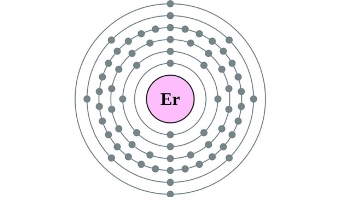Mar 21 2014
At sub-micro-kelvin temperatures atoms or molecules move so slowly that it is better to think of them as spread-out, wavelike things a micron or more across, many times larger than any putative bond length (typically sub-nanometer in size) that would characterize bound molecules.

Experiments over several years have shown that collisions and chemical reactions do take place---surprising, considering the scant energy available to the reactants---but under the sway of wavelike, and not particle-like, considerations.
A new experiment conducted at the University of Innsbruck in Austria adds a new twist to this picture. There swarms of erbium atoms were held in a special trap and cooled to a temperature of about 300 nK. Er-166 and Er-168 are boson species, which means that these atoms can clump very closely together in a single quantum state known as Bose Einstein Condensate. But because of the erbium’s large intrinsic magnetic moment, inter-atom interactions are strong. By imposing an extra magnetic field---the better to excite Feshbach resonances, which are delicate bound molecular states---the types of collisions among atoms can be controlled. The Innsbruck physicists expected that the use of Er atoms would give rise to a number of such resonance states.
It came as a great surprise to them, therefore, to observe a hundred and more resonances rather than a dozen or so. The resonances were so great in number and so densely packed that the researchers deduce that a form of quantum chaos is at work here.
Quantum chaos, as a research subject, is only a few decades old. It features systems of particles exhibiting both quantum and chaotic behavior---chaos being usually thought of as classical-physics phenomenon. A classical system is generally deemed to be chaotic if its future course is described by nonlinear equations and if predictions of future behavior are exquisitely dependent our knowledge of the initial conditions of the system. The signature of quantum chaos is somewhat different: a dense set of energy levels with a special kind of spacing between levels.
The Innsbruck experiment represents the first instance of quantum chaos observed for ultracold atomic collisions. The results are reported in Nature in a paper published online on 12 March (1). JQI scientist Paul Julienne, as an expert on particle collisions at cold temperatures, was asked to write a commentary on this appearance of cold chaos. His essay appears in the same issue of Nature (2).
MORE THAN THEY BARGAINED FOR
As the strength of the external magnetic field is varied in the Innsbruck apparatus, new collision conditions become available. At certain field values the nearly-at-rest atoms come into resonance, and form weakly bound molecules; these molecules, when struck by a third atom, form a threefold object which can no longer be held by the trap. Thus a decrease in the atomic population marks the location of the resonance energies.
The hundred resonances actually observed while varying magnetic field across a fixed range was more than the researchers had expected and far more than had ever been observed before---typically in studies of alkali elements such as cesium. The bad news was that studying atomic collisions at these temperatures suddenly got a lot more complicated.
The good news is that all these new collision alternatives might open up new avenues in low-temperature physics research. “Part of the power and the beauty of cold atom physics,” said Julienne in his News & Views essay in Nature, “is that the scattering length can be made to take on any value by tuning a magnetic field close to a Feshbach resonance. Its value controls the two-body, few-body, and many-body physics of ultracold quantum matter. Thus, controlling the field makes the system dance to our tune.”
Still more complex than erbium atoms are molecules. They are currently hard to cool to nK temperatures because of their great complexity; energy continues to lurk in various rotational and vibrational modes of molecules. But molecular cooling is advancing and soon molecular chemistry at the coldest temperatures might be doable. It would not be surprising to find a similar kind of chaos at play there.
(1) “Quantum Chaos in Ultracold Collisions of Erbium,” Albert Frisch, Michael Mark, Kiyotaka Aikawa, and Francesca Ferlaino, John L. Bohn, Constantinos Makrides, Alexander Petrov, Svetlana Kotochigova, Nature, online 12 March 2014
(2) Paul Julienne, Nature, published online 12 March 2014
- See more at: http://jqi.umd.edu/news/cold-chaos#sthash.OcWKwUtL.dpuf